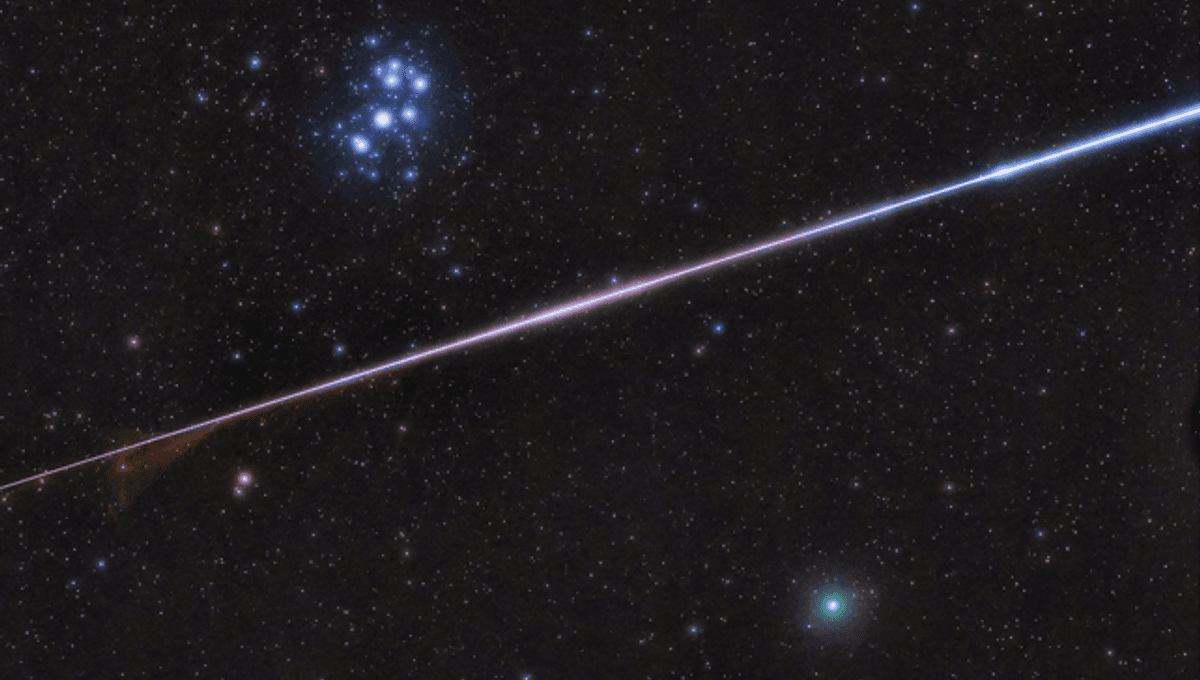
When the unusually alcoholic comet 46P/Wirtanen approached the Sun in 1974, it left a trail of dust behind. Five astronomers have calculated the path of this debris and predict the Earth should hit it on December 12 this year, and possibly on the same date in future years, creating a new regular meteor shower.
At certain times each year, the number of meteors lighting up the skies picks up – at least away from city lights. As well as the random assortment of bright flashes one sees coming from all directions, there’s an extra show all appearing to emerge from the same point (or at least patch) in the sky, known as a radiant. These are known as meteor showers. While most involve so few meteors they are hard to detect above the ordinary background, a few are utterly spectacular, with fortunate observers seeing hundreds of “shooting stars” an hour.
With one exception, all known meteor showers are composed of material left behind during a comet’s passage. Since comets are “dirty snowballs”, when their ice melts the dirt is left behind, unbound to float in space on an orbit similar to the former comet. When Earth passes through the cloud of particles – which usually occurs on the same day each year – those that hit the atmosphere at great speed burn up, bringing a touch of magic to all that see them.
If a paper submitted to Astronomy and Astrophysics, but yet to pass peer review, is correct, December 12 could soon be added to the list. The low speed of impact (10.2 km/s, or 23,000 mph, is close to the bottom of meteor speeds) suggests they will not be particularly bright. The compensating advantage of slower meteorites is if you do see one, you get to watch it cross the sky and even alert friends, and there could be a lot of them.
The paper’s authors focused on the question of when the shower should peak, rather than worrying about just how impressive it will be. Nevertheless, they point to some evidence, including how explosive this comet is, that implies the number of meteors could be unusually high, even for a shower.
They used several different models to try to answer the timing question, and all provide a result of between 8:00 and 12:30 UT (also known as Greenwich Mean Time) on December 12. By coincidence, that’s 7-11 hours after parts of the world will be seeing the asteroid Leona block out Betelgeuse, making this potentially one of the great nights of history for amateur astronomers.
That timing means the shower will occur in daylight for Europe and Africa, although parts of the Americas might catch a glimpse before dawn. On the other hand, it’ll be evening in Australia and East Asia.
The paper predicts the shower’s radiant will be in Vela or Puppis, somewhere between 38 and 44 degrees south. That will put most of the meteors below the horizon from Japan or northern China, but they should be visible from much of South-East Asia and almost overhead in Australia. This would be sweet revenge for southern hemisphere skywatchers, long annoyed by the fact that most of the best meteor showers favor the north.
Meteor showers are not the same each year – gradually, the Earth sweeps up so much dust that over time there is less left behind, and showers fade away. Moreover, pressure from the solar wind or gravitational tugs on the dust particles can move them around so that some years we miss the main belt, passing through an outlying region instead. The Leonids are the most famous example of this; in most years an unremarkable shower with few meteors, but occasionally so spectacular as to provide memories that last a lifetime.
Forecasting the good years has advanced dramatically since the start of the century, but still involves a degree of uncertainty, with some hopeful calls failing to materialize. Predicting a new shower is harder still, particularly when the parental comet regularly passes close enough to Jupiter to be affected by its gravity.
If the forecast comes true, however, future occurrences of this shower – which should all happen close to the same date – should be easier to predict.
The preprint is available on ArXiv.org
Source Link: We Could Witness A New Meteor Shower's Birth From An Alcoholic Comet Next Week